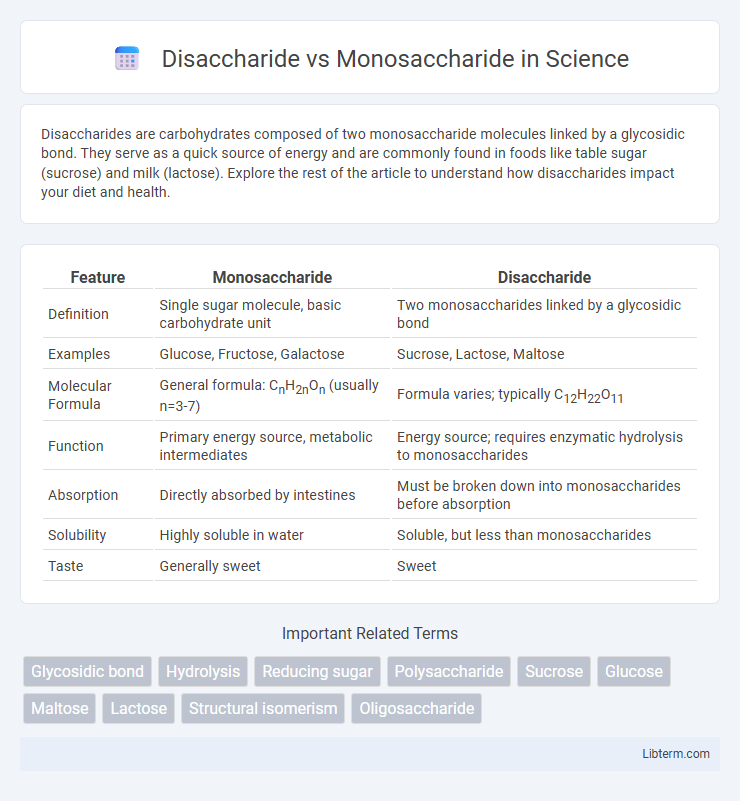Disaccharides are carbohydrates composed of two monosaccharide molecules linked by a glycosidic bond. They serve as a quick source of energy and are commonly found in foods like table sugar (sucrose) and milk (lactose). Explore the rest of the article to understand how disaccharides impact your diet and health.
Table of Comparison
| Feature | Monosaccharide | Disaccharide |
|---|---|---|
| Definition | Single sugar molecule, basic carbohydrate unit | Two monosaccharides linked by a glycosidic bond |
| Examples | Glucose, Fructose, Galactose | Sucrose, Lactose, Maltose |
| Molecular Formula | General formula: CnH2nOn (usually n=3-7) | Formula varies; typically C12H22O11 |
| Function | Primary energy source, metabolic intermediates | Energy source; requires enzymatic hydrolysis to monosaccharides |
| Absorption | Directly absorbed by intestines | Must be broken down into monosaccharides before absorption |
| Solubility | Highly soluble in water | Soluble, but less than monosaccharides |
| Taste | Generally sweet | Sweet |
Introduction to Carbohydrates
Disaccharides and monosaccharides are fundamental types of carbohydrates, essential for energy metabolism in living organisms. Monosaccharides, such as glucose and fructose, are the simplest sugars, consisting of single sugar molecules that serve as building blocks for more complex carbohydrates. Disaccharides, including sucrose and lactose, are formed by the chemical bonding of two monosaccharide units through glycosidic linkages, playing a crucial role in carbohydrate digestion and absorption.
What Are Monosaccharides?
Monosaccharides are the simplest form of carbohydrates consisting of single sugar molecules such as glucose, fructose, and galactose, which serve as fundamental energy sources for cellular processes. They have a general molecular formula of (CH2O)n, where n typically ranges from 3 to 7, and cannot be hydrolyzed into smaller carbohydrates. Unlike disaccharides, which are composed of two monosaccharide units linked by glycosidic bonds, monosaccharides provide the essential building blocks for more complex carbohydrates and play a vital role in metabolic pathways like glycolysis.
What Are Disaccharides?
Disaccharides are carbohydrates composed of two monosaccharide molecules linked by a glycosidic bond, such as sucrose, lactose, and maltose. These molecules serve as a quick source of energy through hydrolysis during digestion, breaking down into their monosaccharide components like glucose and fructose. Common disaccharides play essential roles in metabolism and food chemistry, influencing blood sugar levels and providing dietary energy.
Structural Differences Between Monosaccharides and Disaccharides
Monosaccharides are the simplest form of carbohydrates, consisting of a single sugar unit with a general formula of (CH2O)n, where n typically ranges from 3 to 7, featuring a carbon backbone with hydroxyl and carbonyl functional groups. Disaccharides are composed of two monosaccharide units linked by a glycosidic bond formed through a dehydration reaction, creating molecules like sucrose, lactose, and maltose. The structural difference lies in the number of sugar units and the presence of a glycosidic linkage in disaccharides, contrasting the single-chain, free aldehyde or ketone group of monosaccharides.
Common Examples of Monosaccharides
Common examples of monosaccharides include glucose, fructose, and galactose, which serve as the simplest form of carbohydrates and are fundamental energy sources in cellular metabolism. Unlike disaccharides such as sucrose and lactose, monosaccharides consist of a single sugar unit and cannot be hydrolyzed into simpler sugars. These monosaccharides play crucial roles in biological processes, with glucose being essential for cellular respiration and blood sugar regulation.
Popular Disaccharides in Everyday Life
Popular disaccharides such as sucrose, lactose, and maltose play essential roles in daily nutrition, with sucrose commonly found in table sugar, lactose present in dairy products, and maltose occurring in malted grains. These carbohydrates consist of two monosaccharide units linked together, providing a quick energy source when hydrolyzed into glucose and other simple sugars. The differentiation between monosaccharides like glucose and fructose and disaccharides influences digestion speed and metabolic impact, crucial for dietary planning and managing conditions like diabetes.
Biological Functions: Monosaccharides vs Disaccharides
Monosaccharides, such as glucose and fructose, serve as primary energy sources and key metabolic intermediates in cellular respiration. Disaccharides like sucrose and lactose act as transportable energy forms, broken down by specific enzymes into monosaccharides for absorption and use in metabolic pathways. Both play crucial roles in energy metabolism, with monosaccharides directly fueling cells and disaccharides facilitating efficient carbohydrate transport and storage.
Digestion and Absorption Differences
Monosaccharides such as glucose and fructose are absorbed directly into the bloodstream through the small intestine's epithelial cells without further digestion. Disaccharides like sucrose and lactose require enzymatic breakdown by disaccharidases, including sucrase and lactase, into monosaccharides before absorption can occur. This enzymatic hydrolysis in the intestinal lumen enables the monosaccharides to be efficiently transported across the enterocytes via specific transporter proteins like SGLT1 and GLUT5.
Health Impacts of Monosaccharides and Disaccharides
Monosaccharides, such as glucose and fructose, are rapidly absorbed into the bloodstream, causing quick spikes in blood sugar levels that can contribute to insulin resistance and increased risk of type 2 diabetes when consumed in excess. Disaccharides, like sucrose and lactose, require enzymatic breakdown before absorption, leading to a slower glycemic response but can still contribute to obesity and metabolic syndrome if intake is high. Both monosaccharides and disaccharides influence energy metabolism, but excessive consumption is linked to cardiovascular diseases and dental caries through their effects on blood glucose regulation and oral bacteria.
Summary: Monosaccharides vs Disaccharides
Monosaccharides, such as glucose, fructose, and galactose, are the simplest form of carbohydrates consisting of a single sugar molecule and serve as the basic building blocks for more complex sugars. Disaccharides, including sucrose, lactose, and maltose, are composed of two monosaccharide units linked by a glycosidic bond, providing a source of quick energy that the body breaks down into monosaccharides during digestion. Both types of sugars play crucial roles in metabolism, with monosaccharides absorbed directly into the bloodstream and disaccharides requiring enzymatic breakdown before absorption.
Disaccharide Infographic

 libterm.com
libterm.com